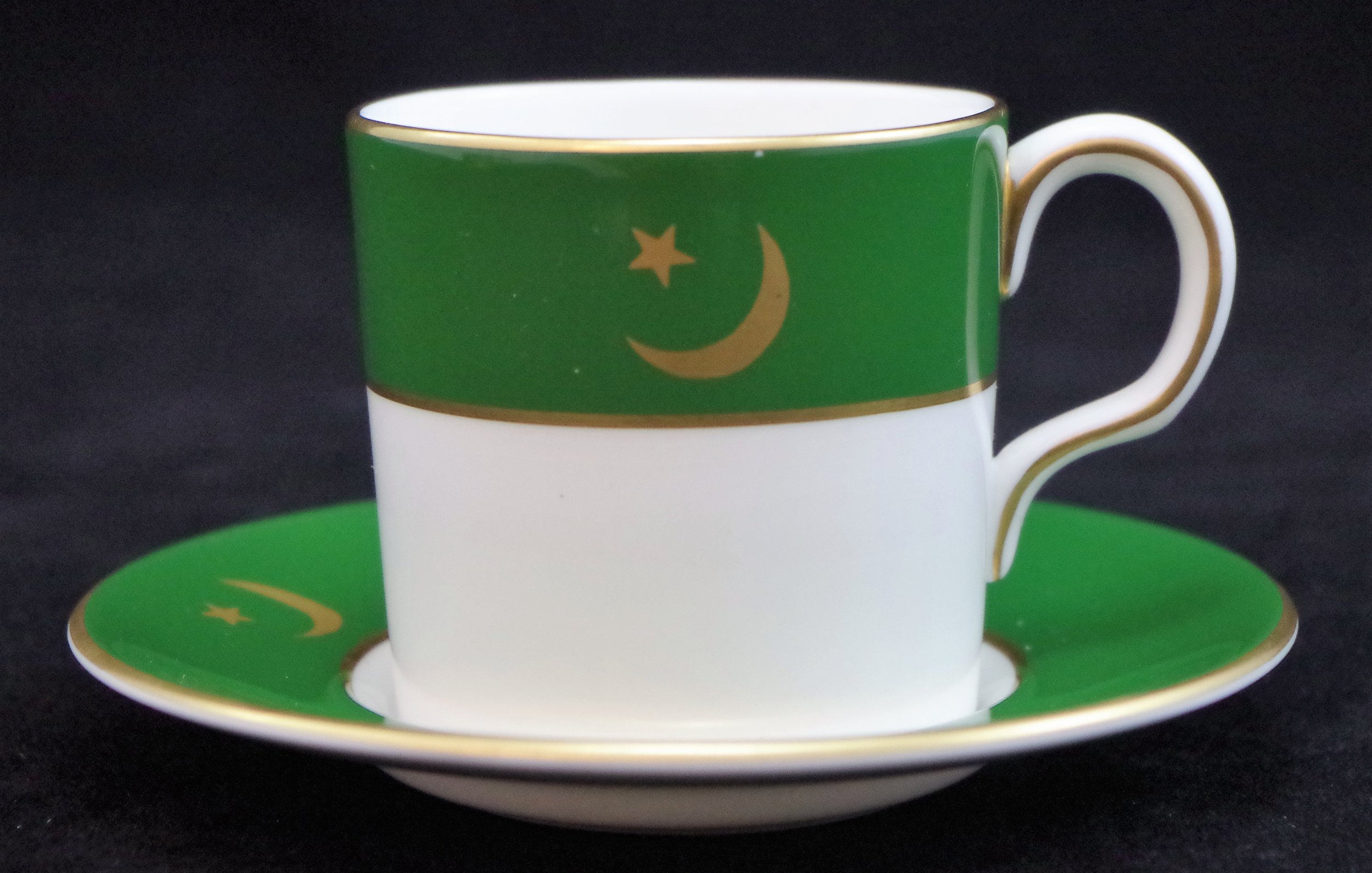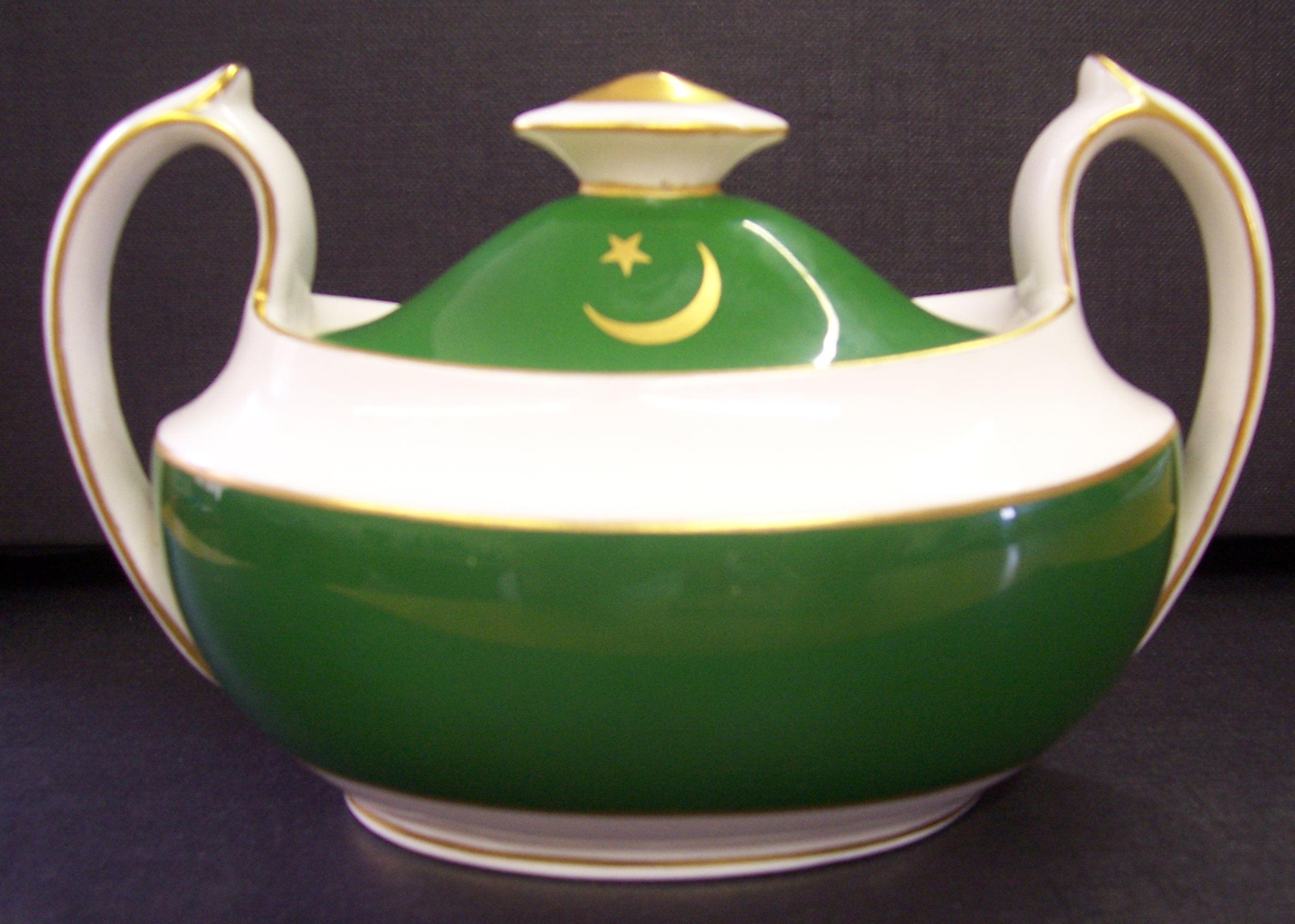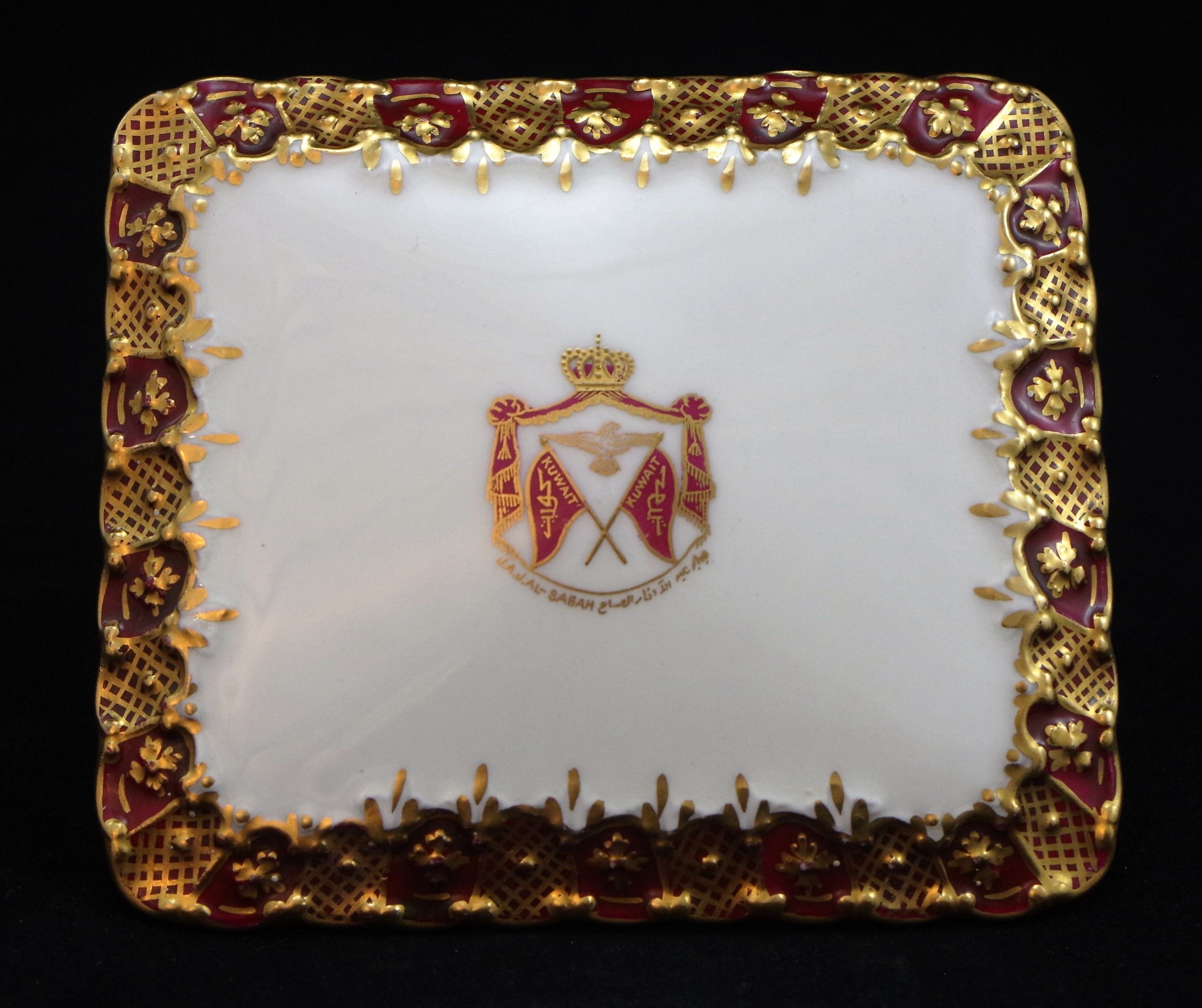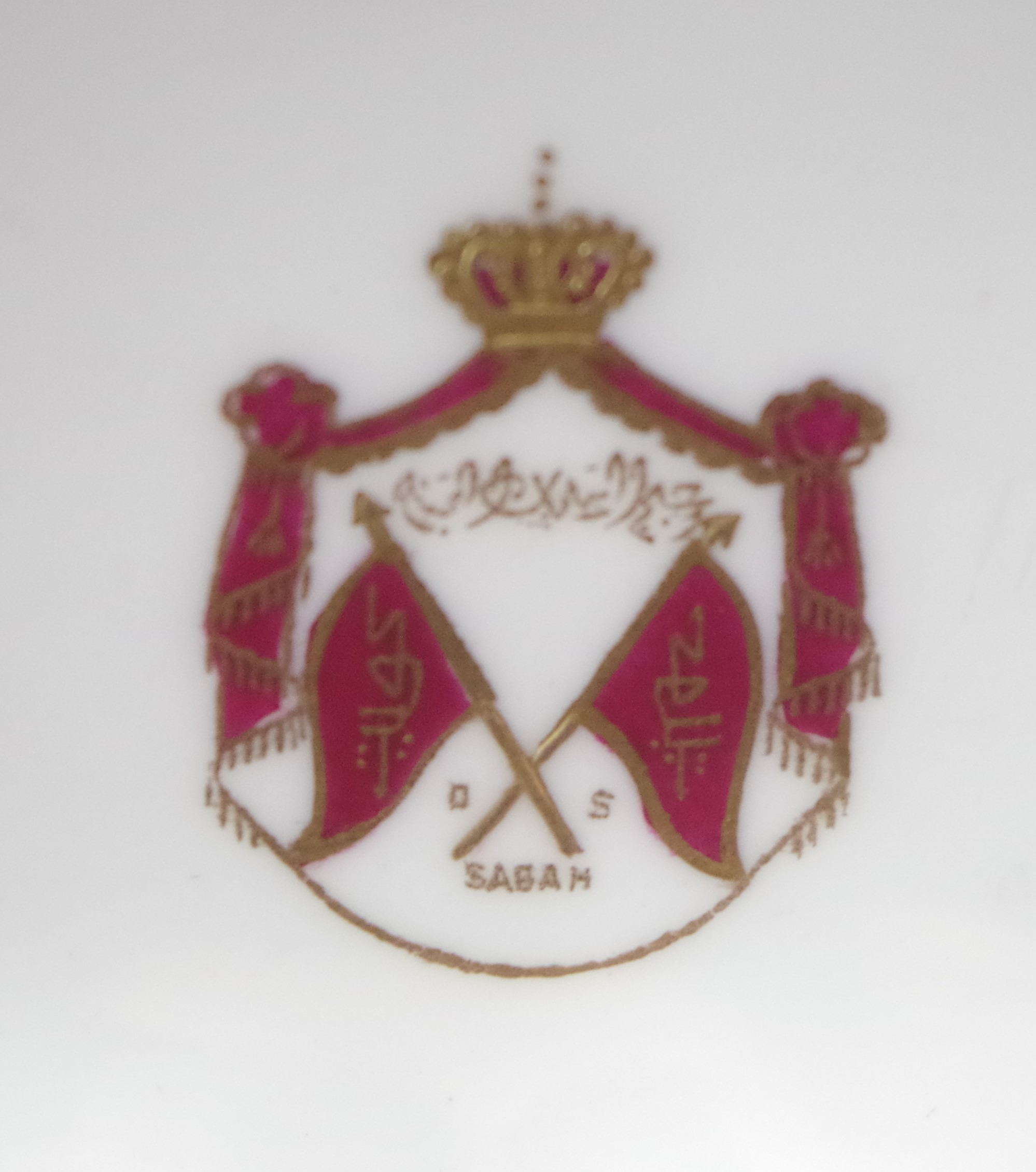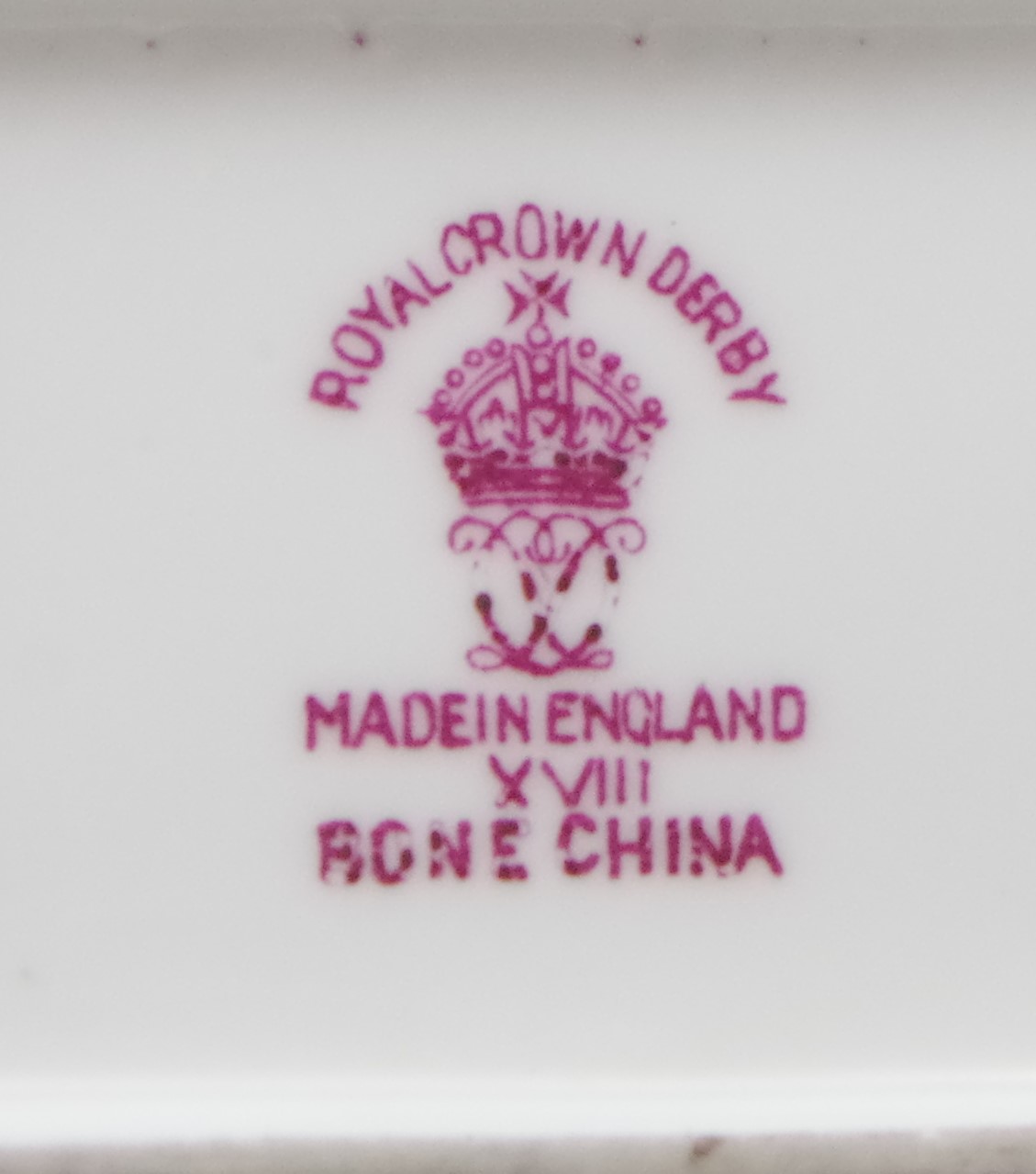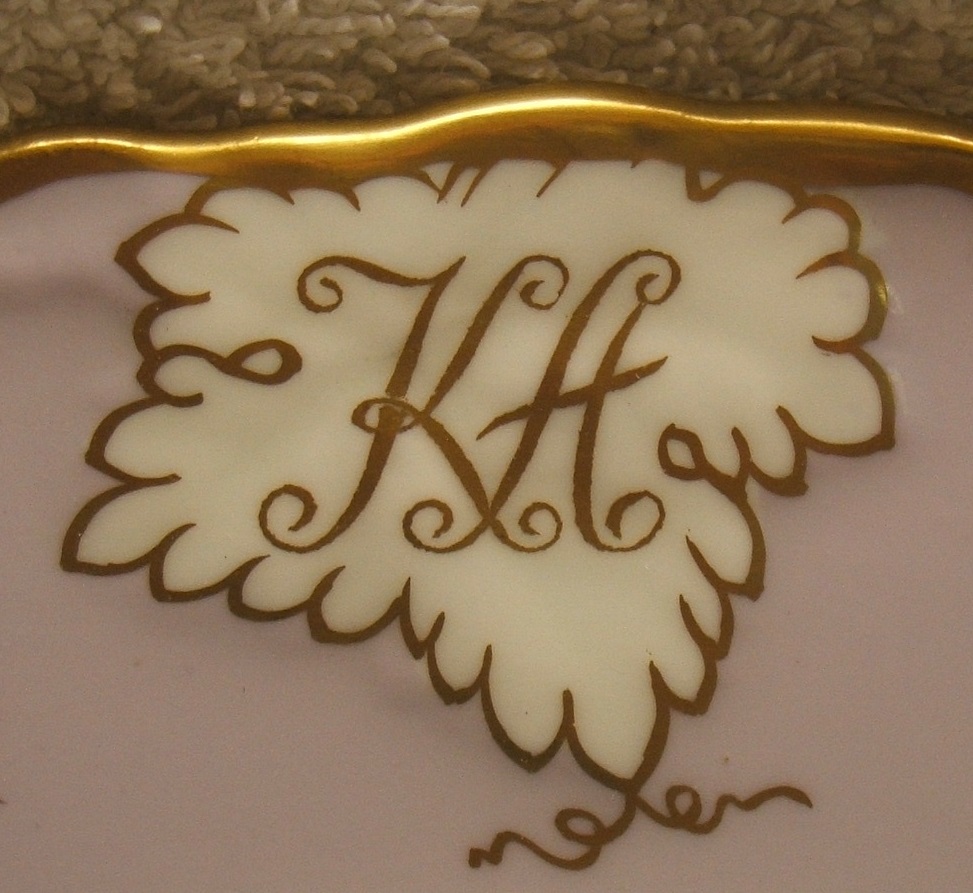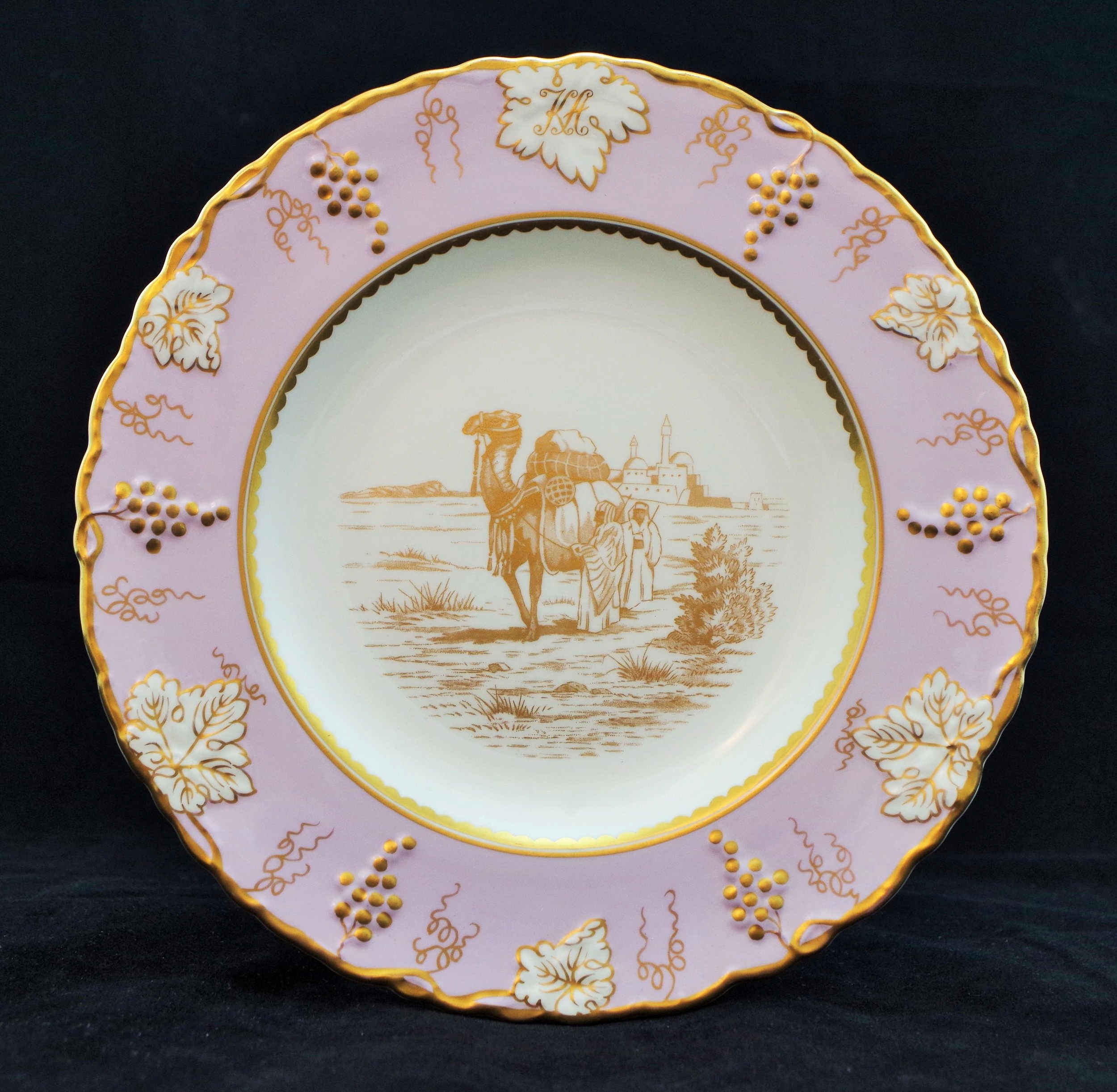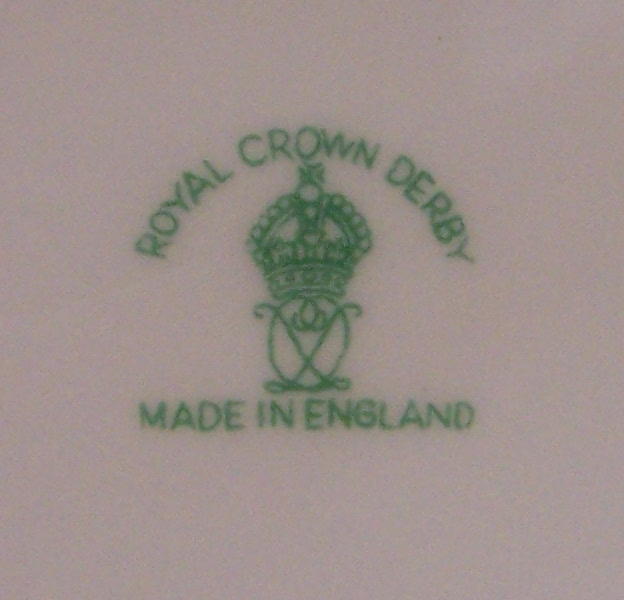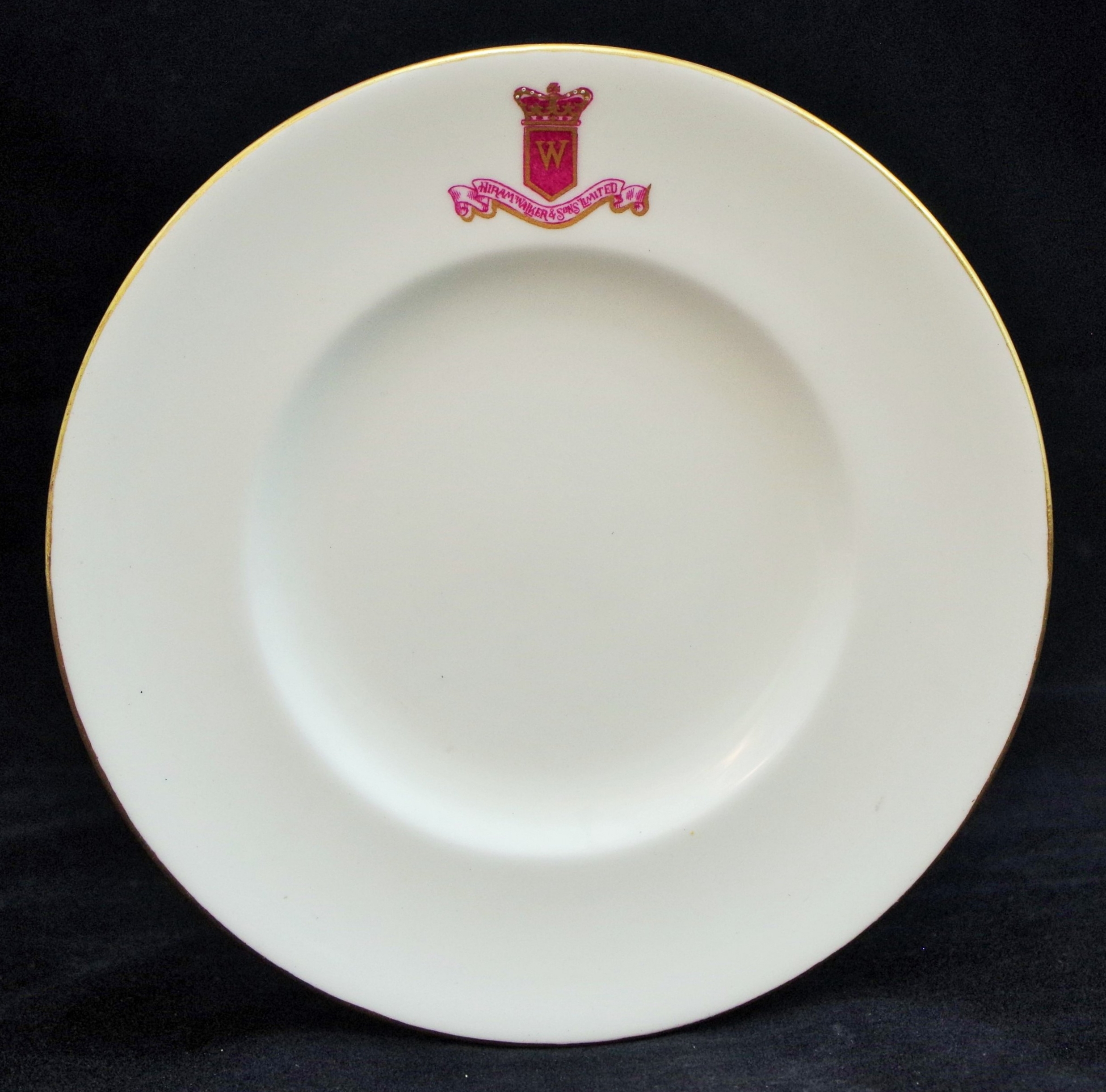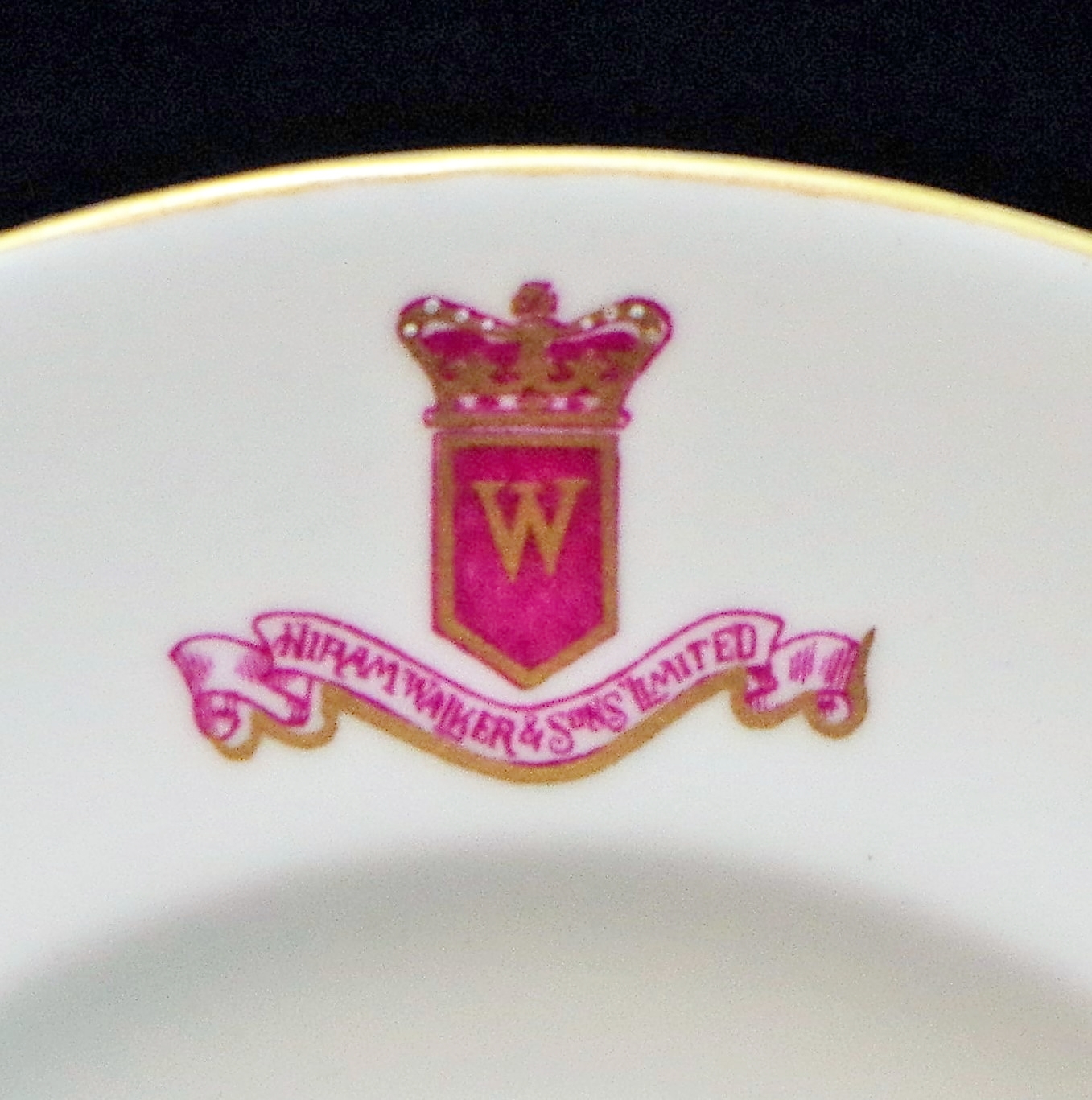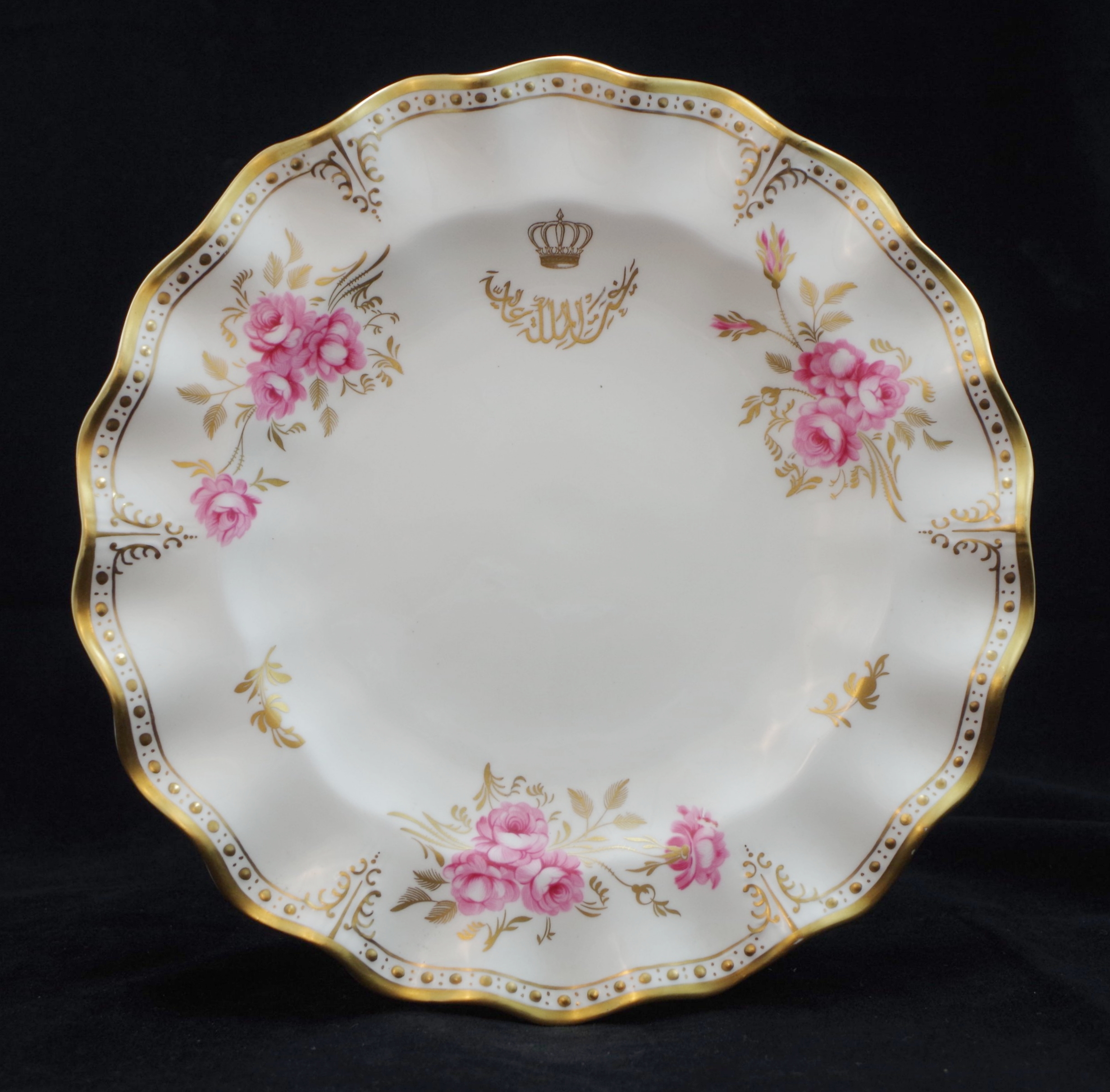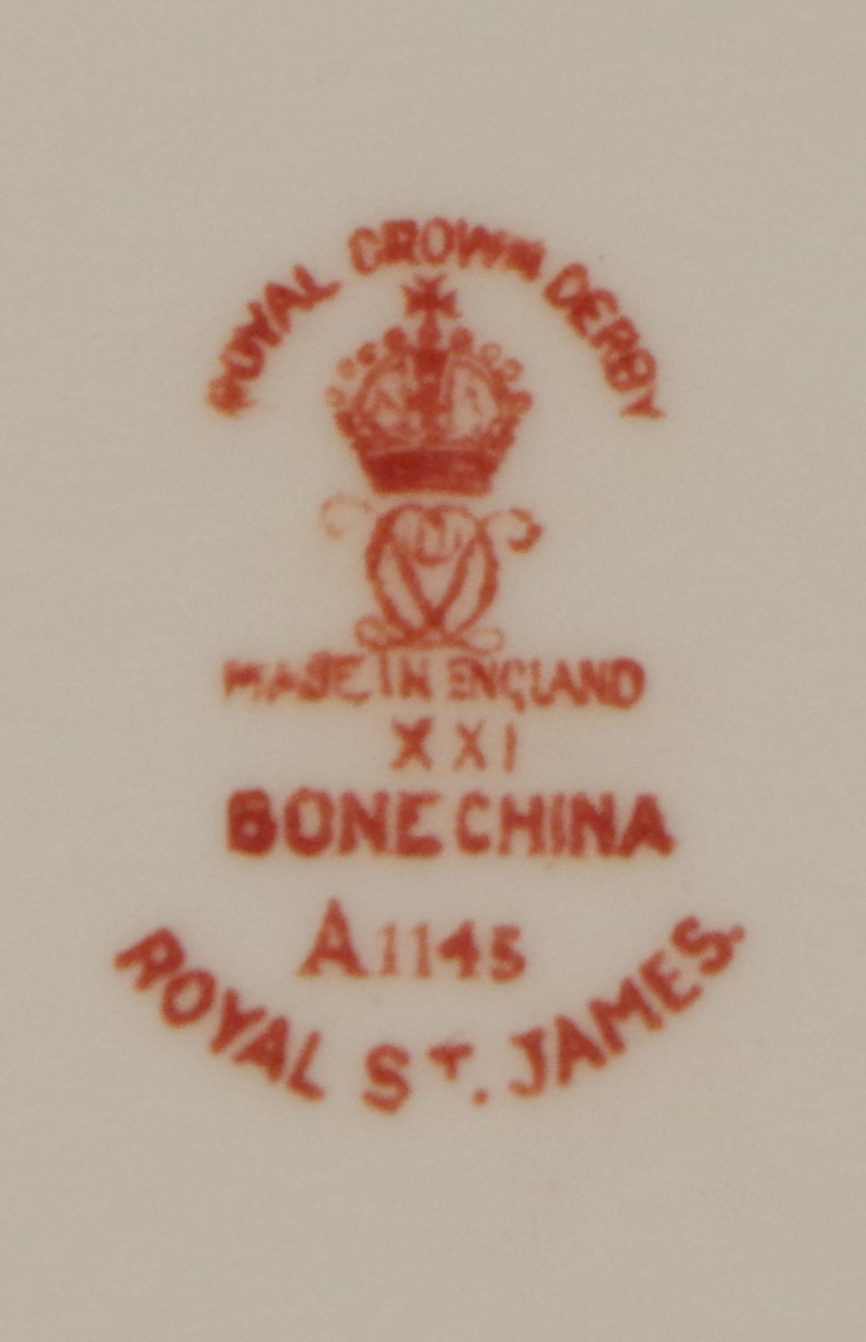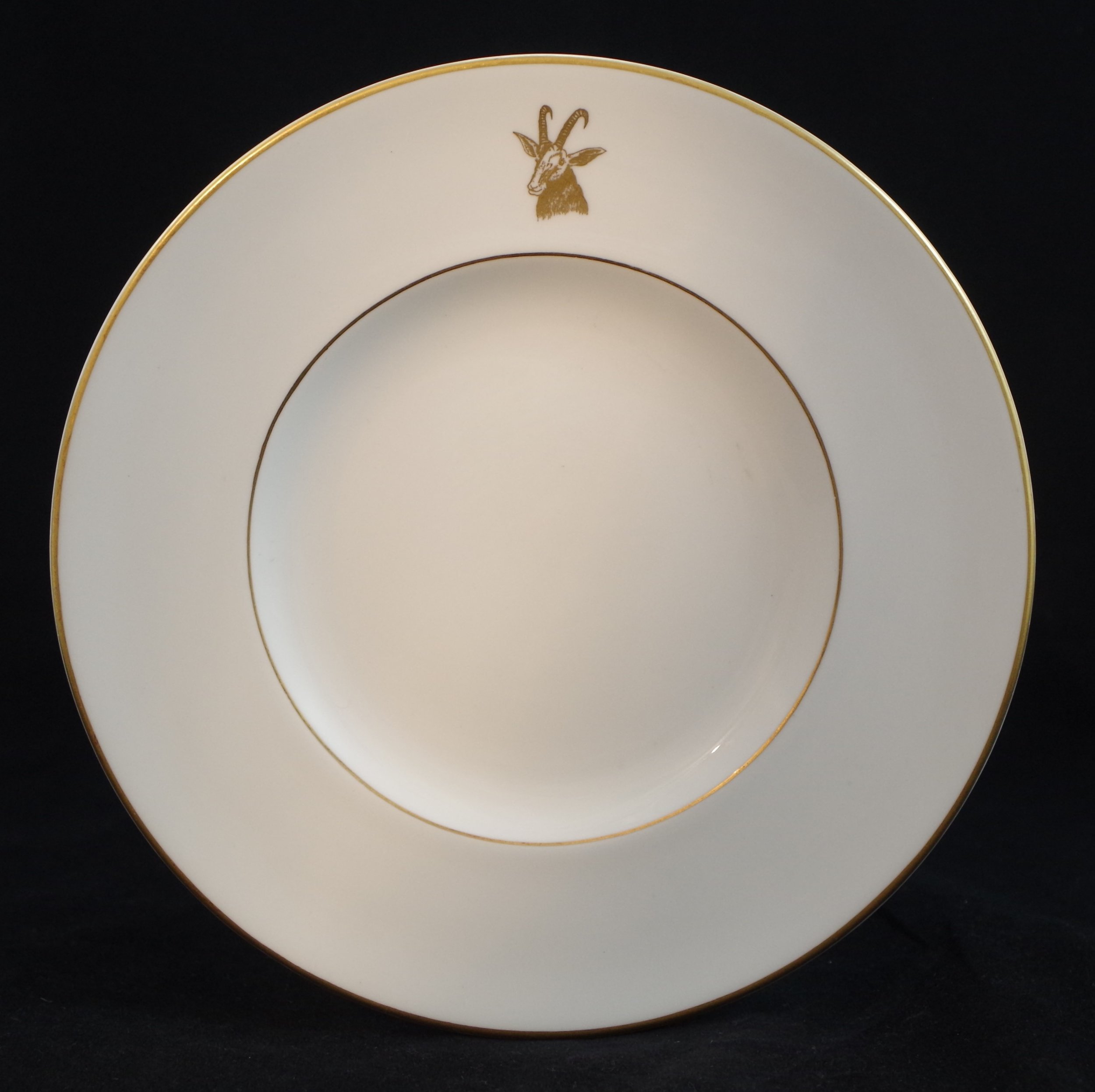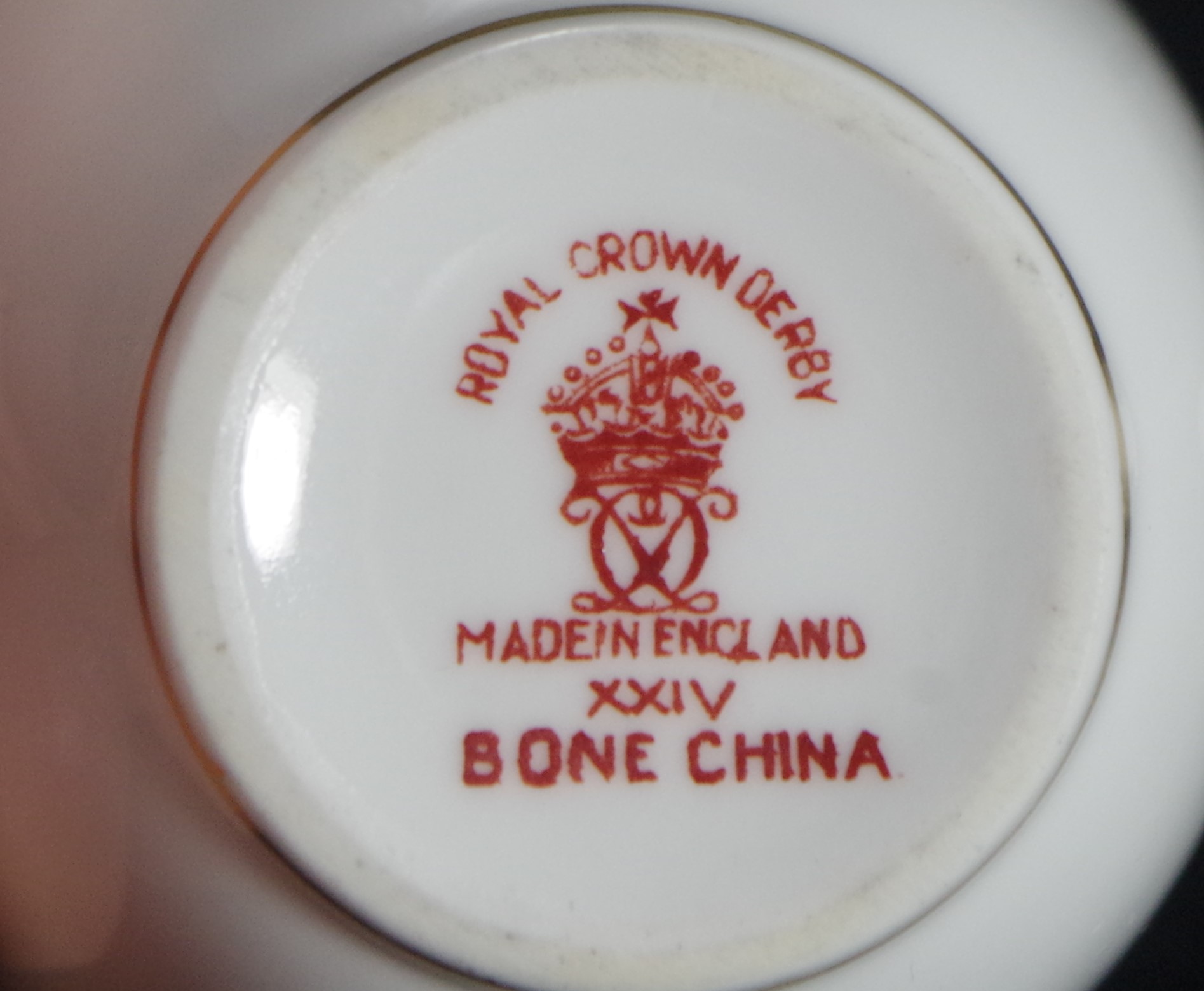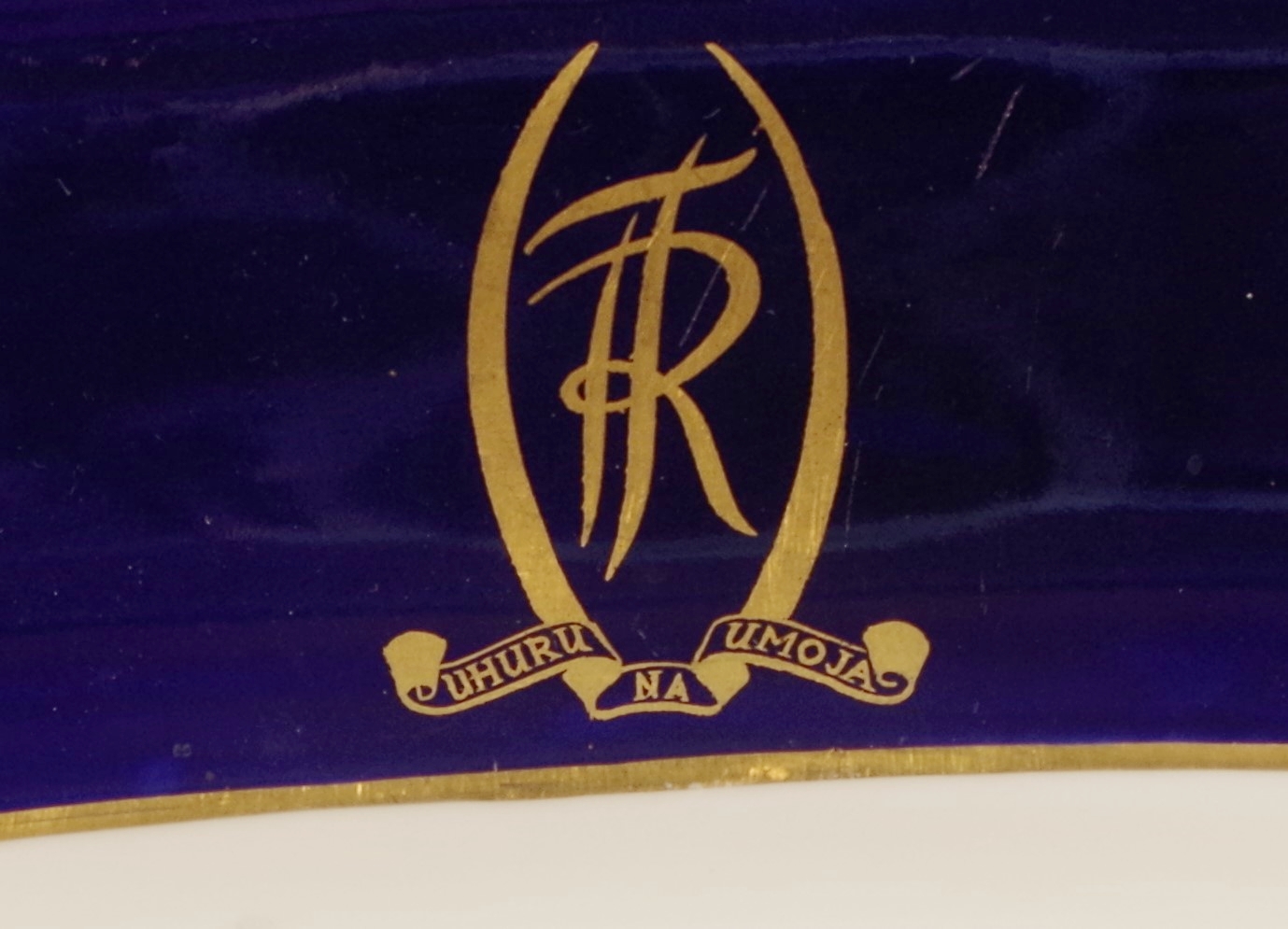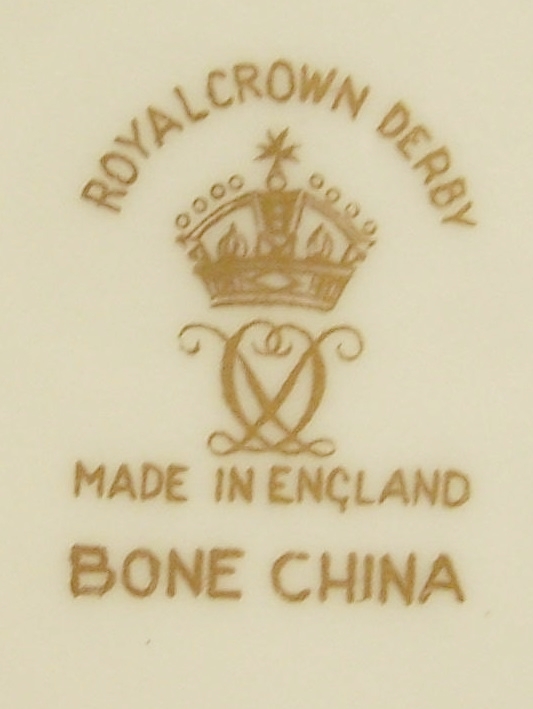Overseas Commissions
A set of four pates, "Fuschia", "Peony", "Iris" and "Chrysanthemum" issued as a limited edition of 1500, produced in 1996 and being a replica of a service designed by Donald Birbeck and painted by William Mosley. The original order was completed in 1941 and comprised a total of 30 different designs. Black and white illustrations appear in John Twitchett's and Betty Bailey's book on Royal Crown Derby (Antique Collectors' Club - 1988). Phillip Robinson confirmed the order with representatives of the buyer at a meeting in London which was particularly memorable for him as it coincided with a heavy bombing raid. The order, which was apparently commissioned to celebrate the coming-of-age of the unnamed Indian Prince, was completed and shipped, but there is some doubt as to whether it was actually ever received by the intended recipient being a casualty of the losses sustained during the war time period. A notice appeared in the Derby Evening Telegraph of Saturday 14th March advertising that a duplicate set was to be exhibited in the China Room of Derby Museum. The official opening was by Lady Nora FitzHerbert of Tissington Hall on Monday 16th March, and the exhibition was open to the public from Tuesday 17th March with a collection for the Mayor's War Fund. A further article with photograph appeared in the paper on Tuesday 17th March. Lady Nora FitzHerbert is quoted as saying "that nearly 95% of the china now produced at the Crown Derby works was exported and that this was a necessary part of our war effort because by the export of this valuable china we were able to buy in return materials for war" The exhibition remained open until Saturday 21st March and raised a total of £65 19s 11d.
Surrey shape tea cup and saucer with the logo of the Soroptimist International Association which includes the motto "Looking Further". Green war time factory mark. I presume that it dates to C1945 but would be grateful for further information. It is noted from the organisation's website that in 1946 the Soroptimists held a reception for delegates to UN conferences which included Eleanor Roosevelt, and that 1952 saw the foundation of the international governing body of the organisation.
In 1951 the Pakistan Government placed an order for 11,000 pieces of banqueting china to be used in its embassies and legations in all parts of the world. In a cutting taken from the Derby Evening Telegraph (sadly undated) it was reported that the china "has so far been sent to embassies and legations in New York, Paris, Moscow, New Delhi, The Hague, Cairo, Teheran, Rome, Ottawa, Rangoon, Canberra, Ankara, Kabul, Damascus, Bagdad, Jeddah, Peking, West Germany and Ceylon. The remainder will be despatched shortly." The sugar box is probably part of this order, but the other pieces are dated 1965 when no doubt further china was purchased.
Plate and large tankard commissioned to celebrate the discovery of the Bahama Islands by Columbus in 1492. Date cipher for 1952. In a article which appeared in the Derby Evening Telegraph of Friday 2nd April 1954 Company director Colin Osborne recounts that the "first consignment of 5000 pieces was sold in four days, and that customers were so eager to buy that they helped the store staff unpack the cases."
Kuwait 1955 - A cigarette box lid in the heraldic shape being part of a dinner service delivered to H.E. Abdullah Mubarak, Chief of Public Security in the state of Kuwait. It consisted of 150 plates, and a gift of a £250 portrait plate. It was captured as a trophy by Saddam Hussein and recovered by the Americans at the end of the second gulf war from his sons' "Love Shack". The matching carving set was a spare. It was the usual practice to manufacture more than one set in case of damage in the firing. The Arabic writing in the central picture translates as "24 Carat Gold". The Arabic writing after the name has a number of inaccuracies which is not surprising bearing in mind that the engraver tasked to replicate the crest would have had no knowledge of Arabic script.
At the same time a service for 12 persons with a similar crest was delivered to H.E. Sheikh Duaij Salman Al-Sabah. An oblong tray is shown above. In an article in the Pottery Gazette and Glass Trade Review January 1956 it was reported that "included were articles thought never to have been potted in this country, namely giant 20-in. rice bowls, and soup tureens, 18 inches high, 28 inches long, and 17 inches wide." Betty Bailey describes the difficulty in gilding the rice bowls because they were too large to emboss - see her book “Gold in my Veins”
Unusual tray dated 1955, not gadroon shape but with gilding as per gadroon. The Arabic writing translates as the initials "M.S."
Part of a service with the crest of Mohammad Reza Shah Pahlavi, the Shah of Persia, later the Shah of Iran. (16th September 1941 - 11th February 1979). I have seen this dated by others to 1969, but this piece is dated XVIII (1955).
Plates in pattern A812 Vine Heliotrope (Lavender) made for Kamal Adham of Saudi Arabia 1955. He is understood to have served as a royal counsellor to both King Faisal and King Khalid. His name also appears on a order made on behalf of H.R.H. Prince Faisal dated 27th January 1958 for a banquet service in design "I" in the Clarence shape initialled "F.A." for 24 persons at a total cost of £3725 5s 2d (C£80,000 in todays money). It would appear that Prince Faisal was appointed to the position of Prime Minister the same year and began a programme of spending cuts in an effort to rescue the state treasury from bankruptcy. Presumably this order was a casualty as so far I have seen no evidence to suggest that the banquet service was actually produced.
A dinner plate with "Crest" of the Maidstone Club. According to Wikipedia "The Maidstone Club is a private country club on the Atlantic Ocean in the village of East Hampton, New York. Maidstone has both an 18-hole and 9-hole private golf course. The Club derives its name from the original name for East Hampton, which was Maidstone, named after Maidstone in England. It was founded as a 7-hole course in 1894 and expanded to eighteen holes in 1899. The Club was the summer retreat of New York City’s most wealthy and socially connected families. Maidstone is considered to be the most elite, prestigious and difficult to get into of all the clubs in “The Hamptons”.
Several notable people have inquired about membership over the years and were summarily prevented from joining the Club. In the 1950s, Groucho Marx was able to play as a member guest but was turned down as a potential member. George Plimpton and Diana Ross were also shunned. Ross was married to billionaire Norwegian shipping magnate Arne Naess Jr., a member at Maidstone, however he resigned when his wife was denied membership. (The club state that she never applied (see https://hamptons-magazine.com/the-maidstone-club-celebrates-125-years). Donald Trump was a temporary member in the early 1980s, but he did not apply to be a permanent member." (Wikipedia). The club seems rather coy about such matters as membership fees (even access to the website is password protected) but it seems that similar private country clubs have "initiation" fees ranging from $100,000-$400,000!
Perhaps the plate was a rejected trial piece as I have not seen any others. Gadroon shape with exquisitely over gilt cobalt ground to rim, inner line and edge. The crest with wording "madyston sigill com : ville regis de :" is based on the local seal of the town of Maidstone in Kent. There is a plaster cast of the original 16C seal in the British Museum collection. Some rather extravagant scrolls have also been added. "The red roundels are from the arms of Archbishop Courtenay, who built All Saints Church, at the end of the fourteenth century. The lion is that of England". See Heraldry of the World - http://www.ngw.nl/heraldrywiki/index.php?title=Maidstone Only the spouting whale logo appears on the club website.
Ceylon. This set was apparently ordered by the Government of Ceylon in 1956. A further order is reported to have been placed in 1967. The plate and coffee cup and saucer are attributed to the later order, the jug (with the thicker gold band) from the earlier. Unfortunately the date cypher "(BONE CHINA)" which has been attributed by Ian Harding as being used between 1954-65 would tend to contradict a date for the more recent order of 1967. Further research is therefore required to determine exactly when these orders were placed.
The Hiram Walker Whisky Company. I have seen this referred to as a set placed through Cassidy's of Montreal in 1964, but this plate is dated XX (1957) so it must have been commissioned well before then.
A plate in the Royal Pinxton Roses pattern dated 1957 which is part of a service made for King Faisal II of Iraq for use on board the Royal Yacht "Queen Aliya". An article in the Daily Telegraph on Monday June 10th 1957 reported that the factory had reduced the normal three day Whitsun holiday to one to cope with the volume of overseas orders, and that this service comprised 400 hundred pieces at a cost of £5000. It is described as being "of the same new fluted shape as that presented recently to the Queen by Derby Corporation" - i.e. in the Royal Pinxton Roses Pattern. King Faisal II was assassinated in Baghdad in the July 14th 1958 revolution and as a consequence this specially commissioned service was never delivered. (Research by Miss H Goodsell).
Coffee Cup and Saucer and plate commissioned by Dr Kwame Nkrumah, President of Ghana. The first version in pattern A1066 on the Heraldic shape dates to 1957, the other pieces to 1958. An article in the Derby Evening Telegraph on the 11th November 1961 reports that Dr Nkrumah was so impressed with the service of some 700 pieces, that he gave instructions that it was not to be used until the Queen could visit Ghana, and it was "fitted into special cabinets at Christianburg Castle, the home of the former Governor General, which was taken over by the Government of Ghana when that country became independent". The first visit by the Queen had to be cancelled and it eventually took place in 1961.
A side plate in the Queen's Gadroon shape dated 1957 from a service ordered by Iskander Mirza, the last Governor General of Pakistan who had become its first President in 1956. Decorated in the national colours of green and white, the top panel incorporates the national emblem of the star and crescent. The factory mark is smudged and this piece was probably sold off as a second.
Plate in the A1145 Royal St James Pattern. Dated 1958. The Arabic writing has been translated as a name "Abdullah Al-Mubarak Al-Sabah" Enquiries have found a Sheikh Abdullah Al-Mubarak Al-Sabah who would have been born around 1958, being the fourth of six brothers, the first born in 1954 and the last two in 1960 and 1962. See http://www.royalark.net/Kuwait/kuwait13.htm
The text to the left of the back stamp translates as Qasr Mushrif, the name of a fort south of Kuwait City. The father of Abdullah Al-Mubarak Al-Sabah named Sheikh Mubarak bin Abdullah Al-Ahmad Al-Sabah Al Sabah (sic) was Deputy Director of Security at the time (HIS father being Director of the Department of Public Security) and it is possible that he may have been residing at the Qasr Mushrif Fort at the time the plate was commissioned. Further research is required.
A plate in pattern A1129. It is possibly a representation on the Emir's palace in Doha, Qatar, which is generally depicted with a flag flying high above it. Dated XXI (1958). Perhaps it is trial piece or part of a service apparently produced for Sheikh Ali bin Abdullah Al Thani (ruled Qatar 1949-60). Further research is required.
A dessert plate dated 1959 with motif which I believe to be a representation of a Roan Antelope. The same image appears at the top of a 1958 share certificate issued by the Roan Antelope Copper Mines which achieved peak production in 1960.
(See http:www.rhodesianstudycircle.org.uk/roan-antelope-copper-mines-ltd-luanshya/)
James Gavin of the Rhodesian Study Circle has kindly replied to an email with the following comments:
"Based on the date and the animal motif, it may be plausible to suggest this plate was created for the Federation by Southern Rhodesia sources (for potentially Government use or the Royal Visits)." The Queen Mother visited Rhodesia in 1957 and again in 1960, her second visit coinciding with the Opening of the Kariba Dam. Further research required.
A plate in pattern A1231 Honiton which unfortunately is undated. This "(BONE CHINA)" factory mark is known to have been used from 1954-65). A report on the Arabic writing reads as follows:- "Just one word, in clear blue lettering: "Mubarak", meaning "Blessed" which is used in greetings, e.g. "Eid Mubarak! Happy Eid!" Mubarak is also a fairly common male name (and also quite popular among the Al-Sabah, see above) but I think it would be unlikely to appear on its own i.e. without "bin Ahmad" or whatever". The script is also considered rather "childlike". *
Cup and saucer in the silver shape with logo for the National Insurance Company of New Zealand Ltd. Factory mark for 1961.
“The National Fire and Marine Insurance Company of New Zealand was founded in 1873. With its head office in Dunedin, it expanded to have operations throughout the world, although it later confined its activities mainly to New Zealand, Australia, the Pacific Islands and London. In 1908 the company was reorganised and changed its name to the National Insurance Company of New Zealand Ltd. In 1961 it bought the failed Standard Insurance Company Ltd, also based in Dunedin. In 1989 National Insurance was purchased by the Tower Corporation.” - See Archives of New Zealand http://thecommunityarchive.org.nz/node/182629/description
Perhaps this set was commissioned to mark the acquisition of the Standard Insurance Company.
Dish from a service marking independence for Tanzania, Undated but would have been produced in 1962/63
* I am very grateful to Mrs Sue Eedle MA (CANTAB) for translating the Arabic writing.








